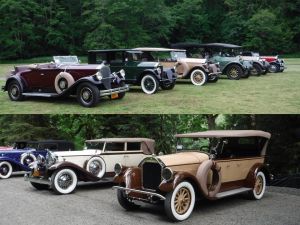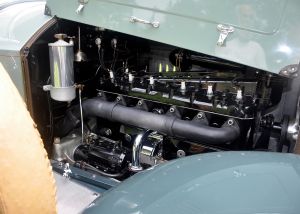- Home
- About Us
- Join/Renew
- Member Benefits
- Member Pages
- Log In
- Help
- Museum Store
I would stay away from Passport. It took over three months for them to deliver the car when two to three weeks was promised, communication from them was non existent and the car was damaged when it arrived.
Dave
It is in the Printed Roster under “Alphabetical Listing By Last Name”. At the end of each listing it is in Brackets, [your # followed by the year you joined]. If you don’t have a printed Roster yet, contact the membership Chair, Janet Lange at [email protected]
Greg, Have you ever used NLGI grade 00 or 000 grade of grease for enclosed u-joints or steering boxes? Both are listed as flowable, with 00 being the consistency of applesauce and 000 like ketchup. The food examples came from a supplier website so don’t blame me for making you hungry. Regular chassis grease is NLGI grade 2 (peanut butter). Dave
Craig,
PASB 72-4 contains a panel discussion and one part of it was information from Henry E. Becker about what he uses in his 1919. He said he replaced the screw-in plug with a grease fitting and used a LOW pressure grease gun to put Moly grease in it being careful not to over grease it. He also commented that they were originally intended to have oil in them as Greg mentioned above.
One other article mentioned that the Series 80-81 and ’29 through ’32 are different from the earlier cars and ’33 on has another type. I don’t know if this is true or not.
This is all I found on u-joint lubrication, so I will endeavor to get one of our experts to put together an article for a future PASB.
Rich, that sounds like a great idea for an article. How about documenting your adventures bringing your car back to life as a start?
Dave
Craig, I’ll do an electronic search through all of the old PASBs this morning to see if I can find something. If there isn’t anything, perhaps I can persuade Greg and others to put something together.
Dave
Luke,
As you mentioned, the most complete place for Board Member information is the printed roster. The printed roster is put together at the beginning of the year so there may have been a few changes to the 2018 Roster by now.
The Regional directors are also listed under their specific region under the “Regions” tab on the left side of the webpage. Click on their name to send them an e-mail. The officers, who are Board members, along with the current webmaster are listed under the “Contact the PAS” tab. Some of the “Board Members at Large” and the “Directors Emeriti” are not listed on the website. -Dave
I think Greg pretty well sums up the improvements I would like to see. There are also some things I don’t want to lose. The red dot that appears on the home page when there is a new message board posting is great, as are the “New” or “Updated” flags that appear on the changed or new threads. They make it easy to find new posts. On most of the forums on other car sites you have to look at the date and time to see what has changed since the last time you were there, if you can remember, which is inconvenient at best.
The “Roster” look up feature is among the best I have ever seen. I can put in the model of my car and get the names and contact info of the members that have similar cars. Or, I can put in my state and get the names of other PAS members near me that I may not otherwise be aware of. I don’t want to lose these features.
While the primary purpose of the Message Board is to exchange information about all things Pierce-Arrow, I also feel it is appropriate for this type of thread to be posted on the Message Board. Several of the posters on this thread are members of the Board and there are other Board members that follow the Message Board regularly. This thread is a great way for the membership to give input to the Board on the website update, all in one place.
I’d like to see the comments keep coming as the more suggestions the Board and Committee have, the better the website will be. As was mentioned above, you can also contact Board members directly.
Dave White
Jim,
I tried it and it sizes a 4000×3000 photo to 960×720. Multiple photos pasted into one slide produces the same size. A good alternative to using a photo program. Great idea.

Rick,
You are going to bring this the meet in Auburn this summer,right? We all have been following the progress and want to see it in person. Dave
Resized to 1200×900 pixels.

If you need more help with it, let me know.
Rick,
You probably need to adjust the resolution of the photo. I post my photos at 1200 pixels on the long side and it has worked every time. If the photo is higher resolution, you will need to downsize it using a photo editing program. Windows 10 comes with a program called “Photos” that has a resize function in it. I use a free download photo organizing program called “FastStone”. It has a resize function under the edit tab.
Unfortunately, there isn’t a way to post multiple photos in a single posting.
Dave
Peter, Your description of copying a link works, OR when you copy it, highlight starting with the www. Like: http://www.pierce-arrow.org. Don’t copy the http://. Copy it, paste it into the “Optional URL” window and the website will add the http://. If you paste the http:// in the box the website adds it again and the link won’t work.
Posting photos has also been a big issue. The key is the resolution of the photo. I post my photos at 1200 pixels on the long side and it has worked every time. If the photo is high resolution, you will need to downsize it using a photo editing program. Windows 10 comes with a program called “Photos” that has a resize function in it. I use a free download photo organizing program called “FastStone”. It has a resize function under the edit tab. Unfortunately, there isn’t a way to post multiple photos in a single posting.
I am working on an article to put in a future PASB on posting links and photos as well as how to search the message board and the Service Bulletin disk. I will also post something on the Message Board. The website update is progressing, however, there are a lot of “behind the scenes” parts of the website that is making it a very time consuming undertaking for the committee.
Ken, Check also with Greg Long, I believe he has / makes an adapter and has the K&N filter info. George Teebay also might be able to help you with this. He had one on his S80 cars.
Peter, Thanks for trying, the dual valve 6 in my Series 36 has a completely different air intake setup than the Series 80/81 even though it is the same era. It has two air intakes, one with a cylindrical screen, the other comes through a passage that passes through the block from the right side below the exhaust manifold to the carb on the left side of the block. I think I am going to go through the K&N catalog and see if there is anything that will fit the opening in the block and possibly make an adapter. There are several simple solutions for the cylindrical screen, it is the other one that I am trying to figure out. It sounds like Ken could use your photos and information.
As a footnote: I am trying to gather information on modern air filter solutions for P-As to put together an article for a future PASB. If anyone has any solutions, please e-mail me any information and photos you might have. [email protected]
Thanks, Dave
Thanks Greg. Have you seen anything that would fit over the flat opening on the right side of the block?
Mark,
All of the above suggestions are good. Your idea of buying the PASB Disk is also good. It has all of the PAS service bulletins going back to the sixties. The latest (2018) PASBs are on the website for download. A lot of information on the disk, some factory service letters, some from knowledgeable PAS members (including some that worked for Pierce) and some Message Board threads. Like you, I prefer printed. I have printed all of the PASBs off the disk that pertain to my car and put them in a binder along with the appropriate section of the “Wiring and Tune up Guide” and the Owner’s Manual(that has a LOT of useful info). The disk is searchable using Adobe Acrobat. The trick to it is using the correct search phrase. Too specific you will get nothing, too general and you will get too many hits. It takes a little practice. This Message Board also has a search feature. The same caveat applies about the search phrase.
As previously mentioned, your Owner’s Manual is downloadable from the “Library” section on this website. The Parts Book and several sales books are listed and are available from the AACA library. Have fun with the new car.
Dave
The Series 36 also has a bypass oil filter that operates as Greg described above. It is the silver canister in the upper left of the photo. The element is replaceable with a farm equipment filter. I can dig up the part number if anybody needs it.
A good air filter is the bigger challenge on the Series 33/36 engines. There are two air intakes on the carb, one a round screen and one that comes into the side of the carb through the block from the right side of the engine below the exhaust manifold( the polished piece behind the water pump outlet pipe is the intake). Just to make it more challenging, there is also a water pipe that goes through the same opening (the valve visible below the air intake) plus some small holes for the water line on the carb side of it. As Paul Johnson referenced above, there also appears to be an opening inside the passage through the block that pulls crankcase air into the intake. So there are a lot of sources for air.
I have been trying to come up with something to filter the incoming air. The round screen could be wrapped, but coming up with something for the block intake is a little more challenging. I have thought about something very thin to go between the carb and the block, but it wouldn’t have much surface area and having to pull the carb loose every time I wanted to clean it would be a pain. If anybody has come up with a good air filter solution for the later dual valve 6’s, please post it. Dave

David, Nor Cal has been seeing a LOT of rain the last week including Sacramento. Several feet of snow in the mountains. Sun is forecast for next week though. We’re sending all of storms to the east, so probably more headed your way…….. Dave
Paul, Where do the fumes get drawn into the intake air? Inside the block, where the warmed air goes through the block from the right side of the block to the carb on the left? -Dave
